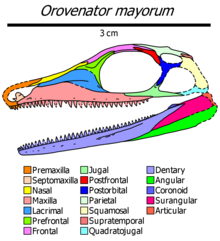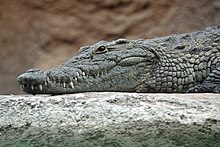| Diapsid reptiles | |
|---|---|

| |
| Skull of Orovenator, one of the earliest known diapsids | |

| |
| Nile crocodile (Crocodylus niloticus) | |
| Scientific classification | |
| Domain: | Eukaryota |
| Kingdom: | Animalia |
| Phylum: | Chordata |
| Class: | Reptilia |
| Clade: | Romeriida |
| Clade: | Diapsida Osborn, 1903 |
| Subgroups | |
| |
Diapsida ("two arches") is a clade of sauropsids (reptiles in the wide sense), distinguished by the presence of two holes, known as temporal fenestrae, in each side of their skulls. Modern reptiles and birds belong to the diapsid subclade Sauria.
The earliest tetrapods with two pairs of temporal fenestrae were the araeoscelidians, which first appeared about three hundred million years ago during the Late Carboniferous.[1] Araeoscelidians are often regarded as the most basal (early-diverging) diapsid reptiles, but have been found by some phylogenetic analyses to instead be stem-amniotes and therefore not closely related to other diapsids.[2] Non-araeoscelidian diapsids are often placed in the subclade Neodiapsida; the earliest known members of this group are Orovenator and Maiothisavros from the Early Permian, around 290 million years ago.[3][4] Two other groups, Parareptilia and Varanopidae, have sometimes been recovered as basal diapsids, but are usually considered to be non-diapsid reptiles and synapsids (stem-mammals) respectively.[5]
Early diapsids were ancestrally lizard-like, but non-saurian diapsids include semiaquatic taxa (like Claudiosaurus and some tangasaurids),[6] the gliding lizard-like Weigeltisauridae,[7] and possibly the Triassic chameleon-like drepanosaurs.[8] The position of the highly derived Mesozoic marine reptile groups Thalattosauria, Ichthyosauromorpha and Sauropterygia within Diapsida is uncertain, and they may lie within Sauria.[9]
Modern diapsids are extremely diverse, and include birds and all modern reptile groups, including turtles, which were historically thought to lie outside the group.[10] Although some diapsids have lost either one hole (lizards), or both holes (snakes and turtles), or have a heavily restructured skull (modern birds), they are still classified as diapsids based on their ancestry. At least 17,084 species of diapsid animals are extant: 9,159 birds,[11] and 7,925 snakes, lizards, tuatara, turtles, and crocodiles.[12]
- ^ "Diapsida". ucmp.berkeley.edu.
- ^ Cite error: The named reference
Simões2022was invoked but never defined (see the help page). - ^ Ford, David P.; Benson, Roger B. J. (May 2019). Mannion, Philip (ed.). "A redescription of Orovenator mayorum (Sauropsida, Diapsida) using high‐resolution μ CT , and the consequences for early amniote phylogeny". Papers in Palaeontology. 5 (2): 197–239. doi:10.1002/spp2.1236. ISSN 2056-2802. S2CID 92485505.
- ^ Mooney, Ethan D.; Maho, Tea; Bevitt, Joseph J.; Reisz, Robert R. (2022-11-30). Liu, Jun (ed.). "An intriguing new diapsid reptile with evidence of mandibulo-dental pathology from the early Permian of Oklahoma revealed by neutron tomography". PLOS ONE. 17 (11): e0276772. doi:10.1371/journal.pone.0276772. ISSN 1932-6203. PMC 9710763. PMID 36449456.
- ^ Cite error: The named reference
Ford2020was invoked but never defined (see the help page). - ^ Nuñez Demarco, Pablo; Meneghel, Melitta; Laurin, Michel; Piñeiro, Graciela (2018-07-27). "Was Mesosaurus a Fully Aquatic Reptile?". Frontiers in Ecology and Evolution. 6: 109. doi:10.3389/fevo.2018.00109. hdl:20.500.12008/30631. ISSN 2296-701X.
- ^ Pritchard, Adam C.; Sues, Hans-Dieter; Scott, Diane; Reisz, Robert R. (2021-05-20). "Osteology, relationships and functional morphology of Weigeltisaurus jaekeli (Diapsida, Weigeltisauridae) based on a complete skeleton from the Upper Permian Kupferschiefer of Germany". PeerJ. 9: e11413. doi:10.7717/peerj.11413. ISSN 2167-8359. PMC 8141288. PMID 34055483.
- ^ Pritchard, Adam C.; Nesbitt, Sterling J. (October 2017). "A bird-like skull in a Triassic diapsid reptile increases heterogeneity of the morphological and phylogenetic radiation of Diapsida". Royal Society Open Science. 4 (10): 170499. Bibcode:2017RSOS....470499P. doi:10.1098/rsos.170499. ISSN 2054-5703. PMC 5666248. PMID 29134065.
- ^ Simões, Tiago R.; Kammerer, Christian F.; Caldwell, Michael W.; Pierce, Stephanie E. (2022-08-19). "Successive climate crises in the deep past drove the early evolution and radiation of reptiles". Science Advances. 8 (33): eabq1898. Bibcode:2022SciA....8.1898S. doi:10.1126/sciadv.abq1898. ISSN 2375-2548. PMC 9390993. PMID 35984885.
- ^ Schoch, Rainer R.; Sues, Hans-Dieter (2016). "The diapsid origin of turtles". Zoology. 119 (3): 159–161. doi:10.1016/j.zool.2016.01.004. PMID 26934902.
- ^ Barrowclough, George F.; Cracraft, Joel; Klicka, John; Zink, Robert M. (23 November 2016). "How Many Kinds of Birds Are There and Why Does It Matter?". PLOS ONE. 11 (11): e0166307. Bibcode:2016PLoSO..1166307B. doi:10.1371/journal.pone.0166307. PMC 5120813. PMID 27880775.
- ^ Reeder, Tod W.; Townsend, Ted M.; Mulcahy, Daniel G.; Noonan, Brice P.; Wood, Perry L.; Sites, Jack W.; Wiens, John J. (2015). "Integrated Analyses Resolve Conflicts over Squamate Reptile Phylogeny and Reveal Unexpected Placements for Fossil Taxa". PLOS ONE. 10 (3): e0118199. Bibcode:2015PLoSO..1018199R. doi:10.1371/journal.pone.0118199. PMC 4372529. PMID 25803280.

